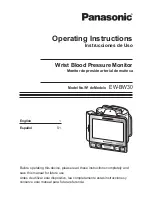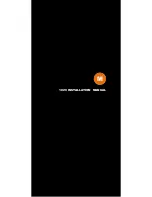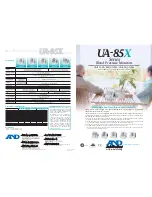
4
3
Important Instructions Before Use
1. Do not confuse self-monitoring with self-diagnosis. Blood pressure
measurements should only be interpreted by a health professional who
is familiar with your medical history.
2. If you are taking medication, consult with your physician to determine
the most appropriate time to measure your blood pressure. NEVER
change a prescribed medication without first consulting with your
physician.
3. Blood pressure can vary based on many factors, including age, gender,
weight and physical condition. In general, a person’s blood pressure is
lower during sleep and higher when he or she is active. Blood pressure
can change easily in response to physiological changes. The setting in
which a person’s blood pressure is measured can also affect the results.
Having one’s blood pressure measured by a healthcare professional in a
hospital or clinic can cause nervousness and may result in a temporarily
elevated reading. Because blood pressure measurements taken in a
clinical setting can vary considerably from those taken at home, a
person’s blood pressure should be measured not only occasionally in
the doctor’s office, but also on a regular basis at home. Also, if you find
that your blood pressure is lower at home, this is not unusual. To
accurately compare with your physician’s reading, take your National
blood pressure meter to your doctor’s office and compare readings in
this setting.
4. People suffering from cardiac arrhythmia, vascular constriction, liver
disorders or diabetes, people with cardiac pacemakers or a weak pulse,
and women who are pregnant should consult their physician before
measuring their blood pressure themselves. Different values may be
obtained due to their condition.
5. Try to take your blood pressure measurements at the same time and
under the same conditions every day.
• The ideal time to measure your blood pressure (to obtain your so-called
“base blood pressure”) is in the morning just after waking up, before
having breakfast and before any major activity or exercise. If this is not
possible, however, try to take measurements at a specified time prior to
breakfast, and before you have become active. You should relax for
about 5 minutes before taking the measurement.
• The following situations may cause substantial variations in blood
pressure readings and should therefore be avoided at least 30 minutes
prior to taking your blood pressure.
Blood pressure will be higher than usual:
- when you are excited or tense
- when you are taking a bath
- during exercising or soon after exercising
- when it is cold
- within one hour after eating
- after drinking coffee, tea or other beverages containing caffeine
- after smoking tobacco
- when your bladder is full
Blood pressure will be lower than usual:
- after taking a bath
- after drinking alcohol
6. Measurements may be impaired if this unit is used near a television,
microwave oven, X-ray equipment or other devices with strong electrical
fields. To prevent such interference, use the unit at a sufficient distance
from such devices or turn the devices off.
7. This unit is designed for use by adults. Consult with your physician
before using this unit on a child. Do not use on infants or toddlers.
8. This unit is not suitable for continuous monitoring during medical
emergencies or operations.
9. Do not use the unit for any purpose other than measuring blood
pressure. Do not use the unit together with other devices.
10. Improper handling of batteries may result in battery rupture or in
corrosion from battery leakage. Please observe the following to ensure
proper use of batteries.
a. Be sure to turn off the power after use.
b. Do not mix different types or sizes of batteries.
c. Change all batteries at the same time. Do not mix old and new
batteries.
d. Be sure to insert batteries with correct polarity, as instructed.
e. Remove batteries when they are worn out, and dispose of them
properly according to all applicable environmental regulations.
f. Do not disassemble batteries or throw them into a fire.
g. Do not short-circuit batteries.
h. Do not attempt to recharge the batteries included with the unit.
EW3111取説−英語 02.12.25 9:26 ページ 3




























